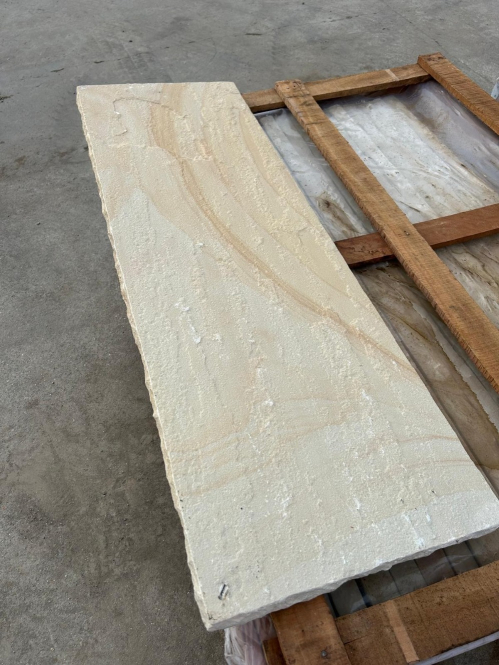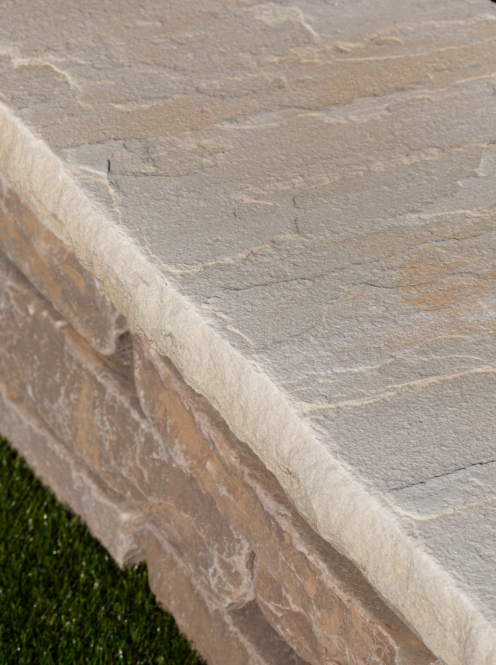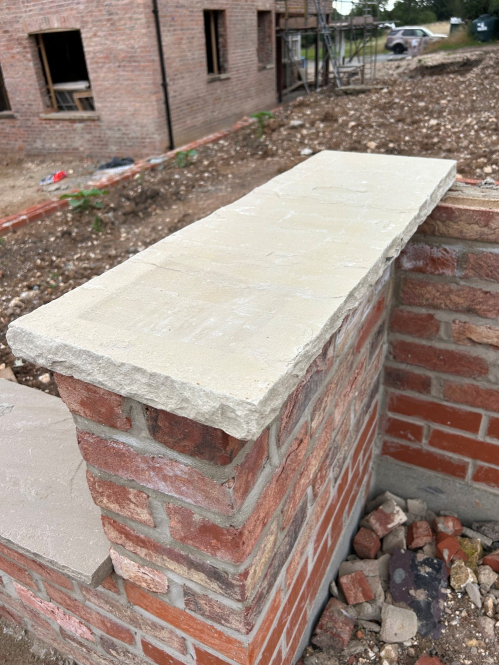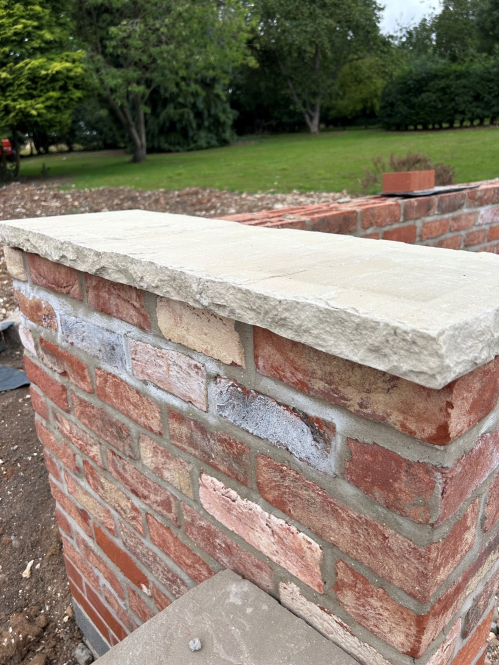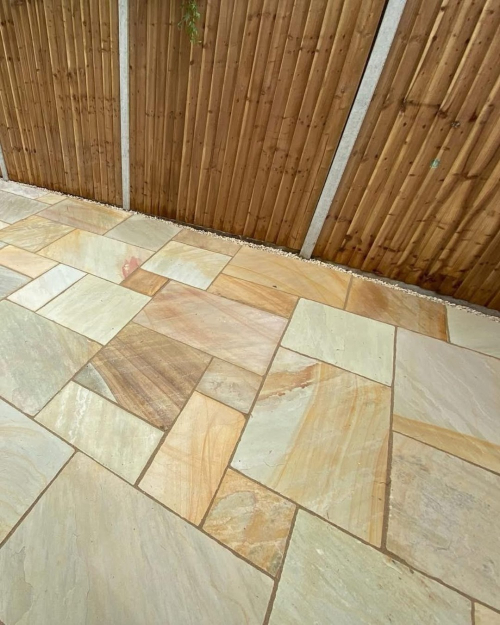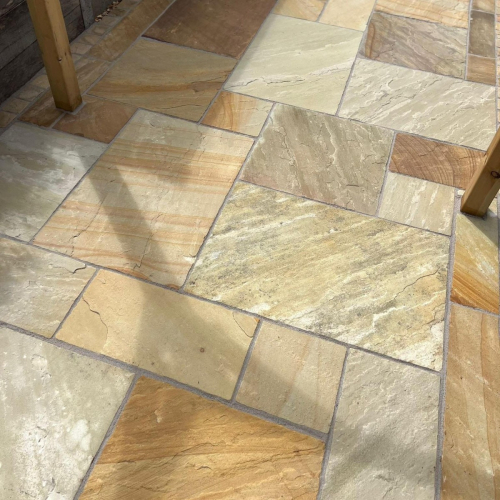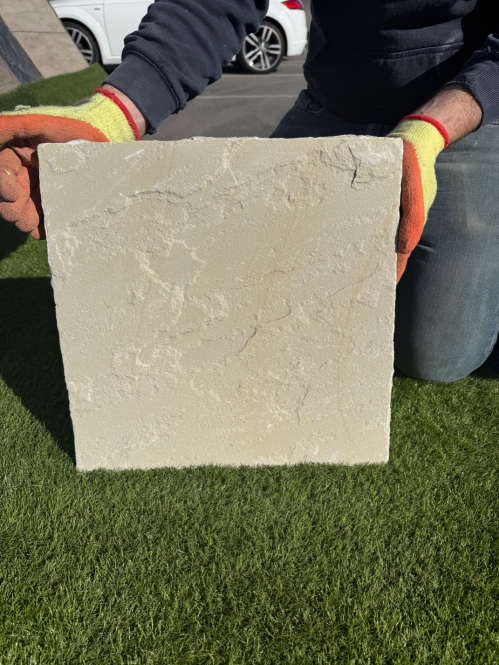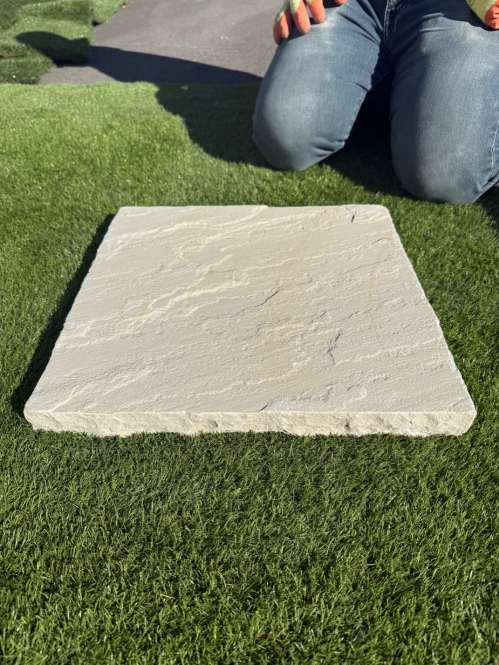Fossil Mint Sandstone
Fossil Mint paving is the ideal way to add a touch of luxury to your outdoor patio space. It is a light ivory coloured natural stone paving that originates from India.
Available in a multitude of finishes and sizes we have a Fossil Mint paving range to suit your garden. Shop our stunning collection of Fossil Mint patio paving slabs today.
- Stunning colour designs
- Light and bright patio paving
- Wide range of size options
- Low Maintenance
If you would to find out more about our beautiful paving selection please contact one of our paving experts today.
Speak to a member of our friendly sales team today on 01482 688008 or Email sales@meltonstone.co.uk
Fossil Mint Sandstone Paving
Does Fossil Mint sandstone paving go green?
Yes, Fossil Mint sandstone paving has the potential to develop a greenish hue over time, especially if it is exposed to moisture, rain, and outdoor elements. This colour change is often caused by the growth of algae, moss, or lichen on the surface of the sandstone. These natural organisms thrive in damp and shaded areas and can gradually cover the surface of the sandstone, leading to the greenish appearance.
The green coloration is more likely to occur in shaded or damp areas where the sandstone is not exposed to direct sunlight and does not dry out quickly. It is a natural process and a common occurrence with many types of outdoor stones, including sandstone.
To prevent or minimize the development of green discoloration on Fossil Mint sandstone paving, consider the following measures:
1. Regular Cleaning: Regularly clean the sandstone surface with water and a mild detergent to remove any dirt, debris, and organic matter that may encourage the growth of algae and moss.
2. Good Drainage: Ensure that the paved area has proper drainage to prevent water from pooling and promote quick drying after rain.
3. Sunlight Exposure: Where possible, allow the sandstone to receive some sunlight, as sunlight can inhibit the growth of algae and moss.
4. Sealing: Applying a suitable stone sealer can help reduce the porosity of the sandstone, making it less prone to absorbing water and potentially slowing the growth of algae and moss.
It's essential to note that while some green discoloration is a natural process, heavy growth of algae and moss can make the surface slippery and hazardous. Regular maintenance and cleaning can help maintain the appearance and safety of your Fossil Mint sandstone paving.
Do I need to seal my sandstone paving slabs?
Sealing Indian sandstone patio pavers is not always necessary, but it can provide several benefits depending on the specific circumstances and the level of maintenance you desire for your patio. Here are some factors to consider when deciding whether to seal your Indian sandstone patio:
1. Stain Resistance: Sealing the sandstone can help create a barrier that prevents liquids and spills from penetrating into the stone, reducing the risk of stains from oil, food, or other substances.
2. Weather Protection: Sealing can provide some protection against the effects of weathering, including fading due to UV exposure and potential damage from freeze-thaw cycles in colder climates.
3. Easier Cleaning: Sealed surfaces are generally easier to clean, as dirt, debris, and moss are less likely to adhere to the sealed surface.
4. Enhanced Appearance: Some sealers can enhance the colour and depth of the sandstone, bringing out its natural beauty.
5. Longevity: Sealing can help extend the lifespan of the sandstone patio by providing additional protection against wear and tear.
What is the best grout for Indian sandstone paving?
The best grout for Indian sandstone paving depends on the specific project requirements, the joint width, and the location of the paving. Generally, for outdoor applications like patios and pathways, a flexible and weather-resistant grout is recommended to accommodate the natural movement of the sandstone and withstand outdoor elements. Two common types of grouts suitable for Indian sandstone paving are:
1. Resin-Based Epoxy Grout: Epoxy grouts are known for their excellent durability, stain resistance, and water resistance. They are less porous than cement-based grouts, making them less likely to absorb moisture and stains. Epoxy grouts also have a high level of flexibility, allowing them to withstand the expansion and contraction of the sandstone due to temperature changes.
2. Polymer-Modified Cement-Based Grout: Polymer-modified cement-based grouts offer good flexibility and adhesion, making them suitable for outdoor applications. They are designed to be more resistant to cracking and shrinking than regular cement-based grouts. Additionally, they provide good water resistance and can handle the dynamic loads experienced in outdoor paving.
When choosing a grout, consider the joint width, the expected foot traffic, the potential exposure to water or moisture, and the climate in your area. It's essential to follow the manufacturer's guidelines for the selected grout, including mixing ratios, application instructions, and curing times.
Is It easy to cut curves in sandstone paving?
Cutting curves in sandstone paving can be more challenging compared to straight cuts, but it is still possible with the right tools and techniques. Here are some factors to consider when cutting curves in sandstone paving:
1. Tools: Using a suitable tool for the job is essential. A wet saw with a diamond blade is commonly used for cutting sandstone paving. Wet saws provide water cooling, reducing dust and preventing overheating of the blade. For intricate curves or small cuts, a grinder with a diamond blade or a specialized curve-cutting tool may be more suitable.
2. Marking the Curve: Before cutting, mark the curve on the sandstone paving using a pencil or chalk. Ensure that the markings are accurate and align with your desired curve.
3. Take It Slow: Cutting curves requires patience and precision. Take your time and make gradual cuts, especially if you are not experienced with cutting curves in stone. Avoid rushing or forcing the blade through the stone, as it can lead to chipping or uneven cuts.
4. Practice and Test Cuts: If you are new to cutting curves in sandstone, it's a good idea to practice on a spare piece or an inconspicuous area of the paving. This allows you to familiarize yourself with the cutting technique and adjust as needed before working on the main paving pieces.
5. Safety Precautions: Always prioritize safety when working with power tools. Wear protective goggles, gloves, and a dust mask to protect yourself from debris and dust generated during the cutting process. Follow the manufacturer's instructions for the tools and equipment being used.
What is sawn and honed?
"Sawn" and "honed" are two different types of finishes applied to natural stone surfaces, including paving slabs and tiles. These finishes impact the appearance and characteristics of the stone, creating distinct looks that cater to different design styles and applications:
Sawn Finish:
- A sawn finish is achieved by cutting the stone with saw blades to create a flat and smooth surface. This process results in a consistent thickness and straight edges for the stone pieces.
- Sawn finished surfaces typically have a more contemporary and modern appearance, featuring clean lines and a sleek look.
- While the surface is smooth, it may retain some slight texture or saw marks, depending on the type of stone and the degree of sawing used.
Honed Finish:
- A honed finish involves grinding the stone surface to create a smooth and even texture. It is less glossy than a polished finish but still provides a clean and sophisticated look.
- Honed surfaces have a matte or satin appearance, offering a more subtle and refined look compared to polished finishes.
- This finish is popular for indoor applications, such as flooring, walls, and countertops, as it provides a comfortable and pleasing tactile experience.
Both sawn and honed finishes offer unique visual and tactile qualities, and the choice between the two depends on the design aesthetic you want to achieve and the specific application of the stone. For example, sawn finishes are often favoured for contemporary outdoor spaces, while honed finishes are well-suited for indoor surfaces where a softer and more understated look is desired.

